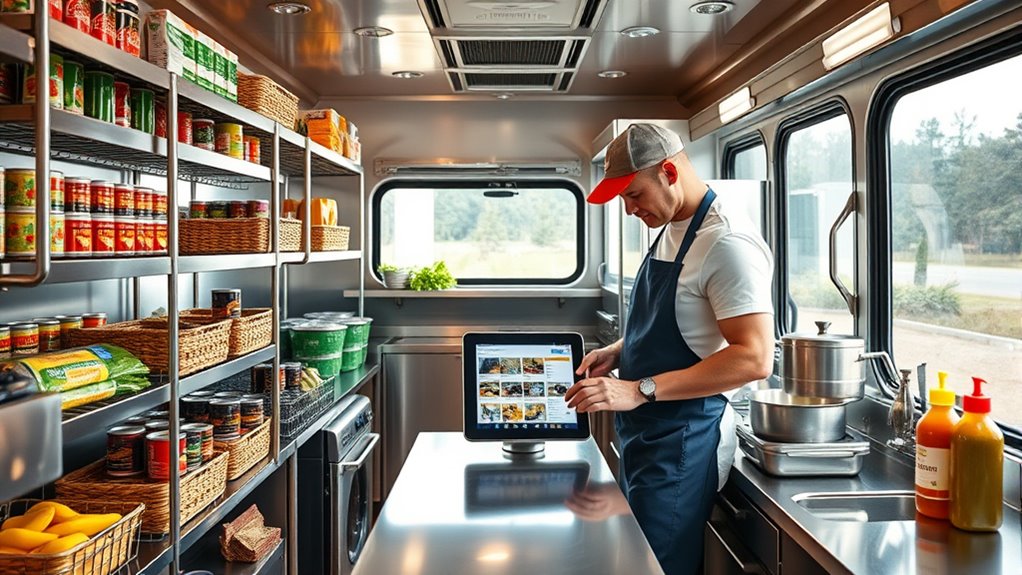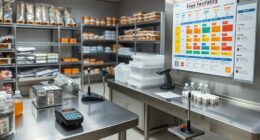Managing inventory in a mobile kitchen requires regular assessment of supplies and ingredients based on your menu and customer preferences. Use a reliable tracking system, whether digital or manual, to monitor stock levels and identify shortages early. Build strong relationships with trusted suppliers for timely restocking and create a schedule aligned with your menu planning. Organize your storage efficiently to minimize waste and handle perishables correctly. To keep everything running smoothly, explore proven strategies that will guarantee you stay prepared for any situation.
Key Takeaways
- Utilize digital inventory management tools with barcode scanning for real-time tracking and accuracy.
- Schedule regular inventory audits and visual inspections to prevent shortages and spoilage.
- Organize storage areas with clear labels and designated zones for quick access and efficient space use.
- Build strong relationships with multiple suppliers to ensure timely restocking and flexibility.
- Track usage patterns and customer feedback to adjust inventory levels and menu offerings accordingly.
Assessing Your Inventory Needs for a Mobile Kitchen
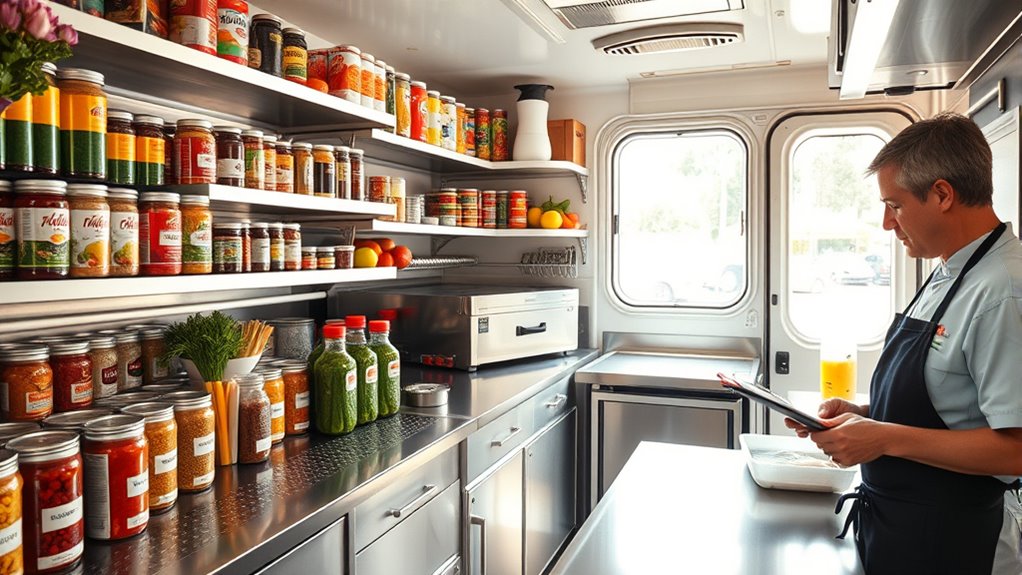
Before hitting the road, you need to determine what supplies and ingredients your mobile kitchen requires. Start by considering your menu customization options, guaranteeing you have all necessary ingredients for your dishes. Think about the variety of meals you plan to serve and how they might change based on customer preferences or seasonal trends. Customer feedback can guide you in adjusting your inventory needs, helping you identify popular items and avoid overstocking less favored ingredients. Keep a list of staple supplies and specialty items tailored to your menu. Regularly review your inventory to prevent shortages or excess stock. Proper assessment upfront ensures you’re prepared to deliver quality food efficiently and adapt to customer demands on the go. Additionally, understanding vetted product safety can help you select reliable supplies that meet safety standards and protect your customers and staff.
Implementing a Tracking System for Supplies
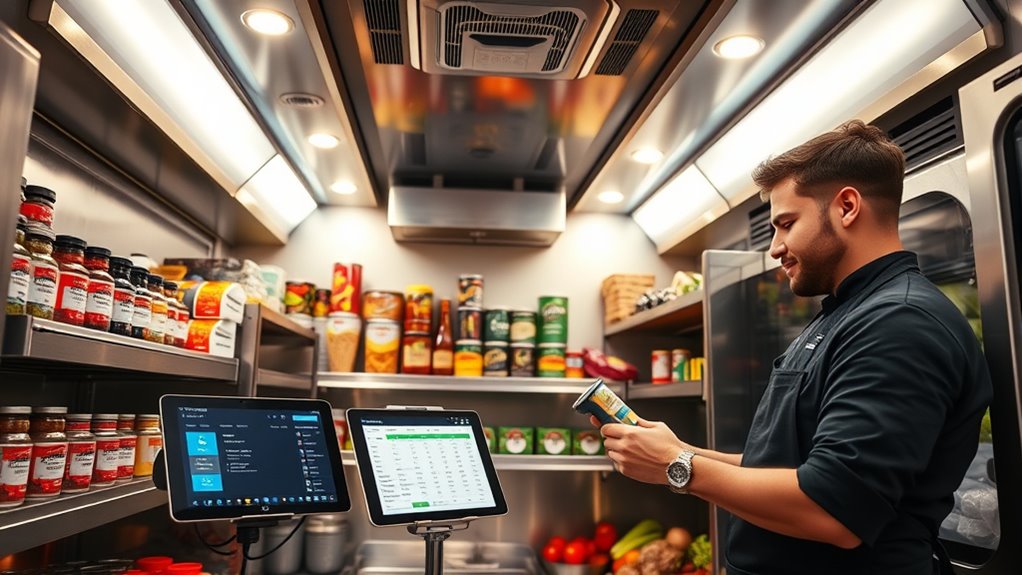
Implementing a tracking system for supplies is essential to keep your mobile kitchen running smoothly. It helps you monitor stock levels, prevent shortages, and reduce waste. Start by choosing a system that suits your needs, whether digital or manual. Regular inventory audits are key; schedule them weekly to ensure accuracy. Train your staff thoroughly on how to record usage, restock, and conduct audits consistently. Clear procedures ensure everyone understands their role in maintaining the system. Use labels, barcodes, or QR codes to simplify tracking and reduce errors. Keep detailed records of supplies received, used, and dispensed. Incorporating a juice cleansing approach can also promote healthier eating habits among staff, contributing to overall wellness. A reliable tracking system saves time, minimizes mistakes, and gives you better control over your inventory, ultimately supporting your kitchen’s efficiency and success.
Establishing Reliable Supplier Relationships

Building strong relationships with your suppliers guarantees your mobile kitchen stays stocked with quality ingredients when you need them. To guarantee supplier reliability and effective vendor communication, consider these steps:
- Vet your vendors carefully to choose those with a track record of punctual deliveries and quality products.
- Maintain open communication by establishing regular check-ins and clear expectations.
- Build trust through consistent orders and prompt feedback on deliveries.
- Diversify your supplier base to avoid dependency on a single source and enhance flexibility.
- Stay informed about industry trends, such as popular products and new suppliers, to make proactive purchasing decisions based on market insights.
Creating a Restocking Schedule
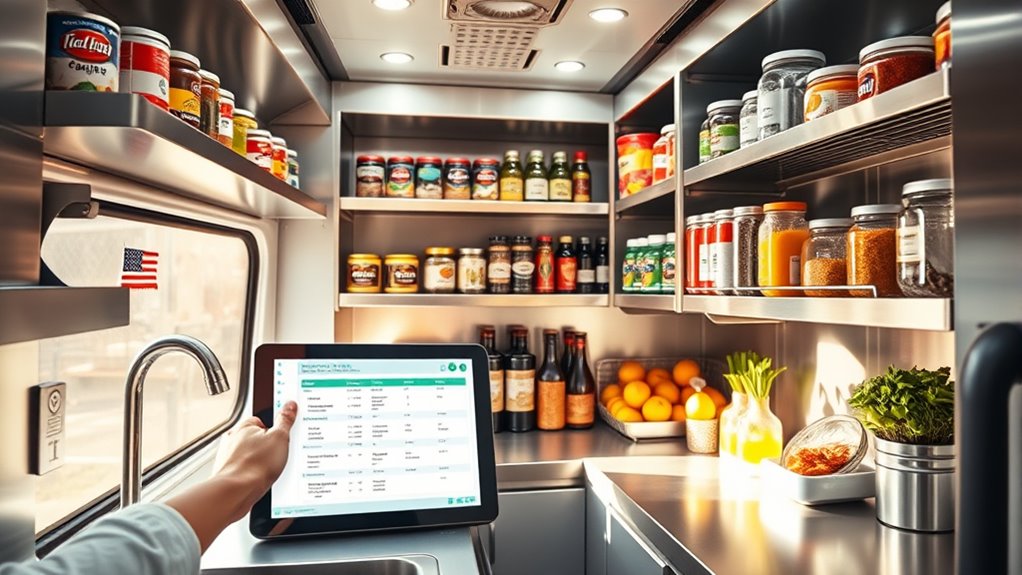
Creating a restocking schedule guarantees your mobile kitchen remains well-stocked without overordering or running out of supplies. To do this effectively, base your schedule on your menu planning, ensuring you have enough ingredients for upcoming dishes. Regularly review customer feedback to identify popular items and adjust your stock levels accordingly. Schedule deliveries around busy days to prevent shortages and slow days to avoid excess stock. Keep track of inventory usage patterns to refine your restocking timeline over time. Consistency is key—set specific days for restocking and stick to them. Additionally, analyzing inventory usage patterns helps optimize your inventory management and reduces waste. This systematic approach helps you maintain a balanced inventory, reduces waste, and keeps your menu fresh and satisfying for your customers.
Managing Perishable and Non-Perishable Items
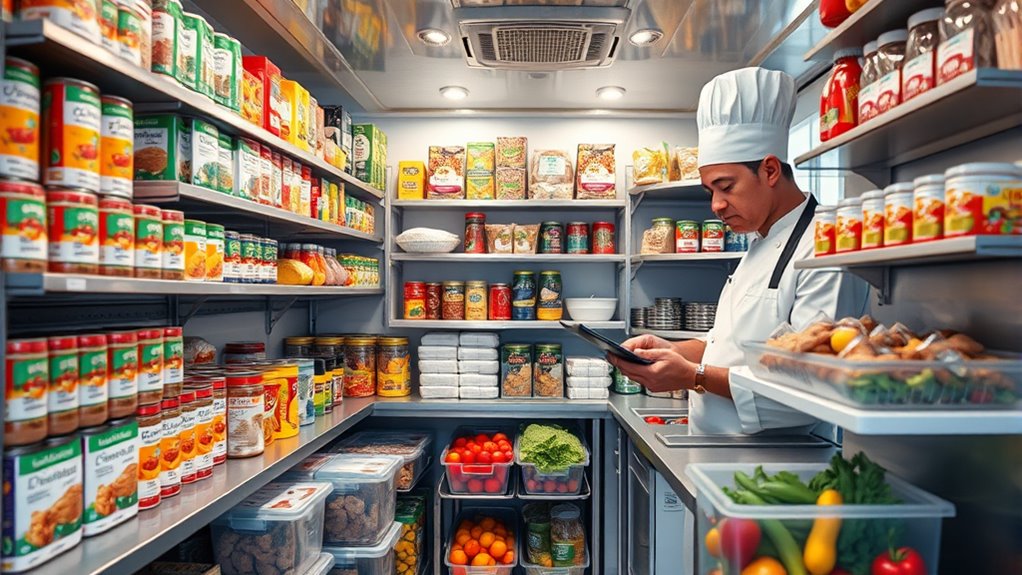
To keep your mobile kitchen running smoothly, you need to understand the storage needs of both perishable and non-perishable items. Proper rotation and regular inventory checks help prevent spoilage and shortages. By paying attention to storage requirements and care, you guarantee all supplies stay fresh and available when you need them. Additionally, implementing Kia Tuning techniques can optimize equipment performance, ensuring your kitchen operates efficiently under demanding conditions.
Storage Requirements and Care
Proper storage is essential to keep your inventory fresh and safe, whether dealing with perishable or non-perishable items. To do this effectively:
- Maintain proper temperature control—keep perishables refrigerated or frozen, and store non-perishables in cool, dry areas.
- Use airtight containers to pest prevention and protect items from contamination.
- Ensure good ventilation to prevent moisture buildup, which can spoil supplies.
- Regularly clean storage areas to avoid mold, pests, and spoilage.
- Consider the water park environment, which may require additional measures to prevent humidity-related issues in storage areas.
Rotation and Inventory Checks
Effective rotation and regular inventory checks are vital for maintaining fresh and safe supplies in your mobile kitchen. By implementing systematic inventory audits, you guarantee perishable items are used before expiration, reducing waste. Use the following table to help prioritize items:
| Item Type | Rotation Method | Check Frequency |
|---|---|---|
| Perishable | First-In, First-Out | Weekly |
| Non-Perishable | Stock Rotation Schedule | Monthly |
| Supplies | Visual Inspection | Before each event |
This approach helps you identify outdated supplies early, cut down on waste, and maintain quality. Regular checks keep your inventory organized, ensuring you always have what you need without overstocking. Staying consistent with inventory audits is key to smooth operations and waste reduction. Additionally, incorporating vegetable juices into your inventory can boost menu health benefits and attract health-conscious customers.
Handling Unexpected Inventory Shortages

When you face unexpected inventory shortages, acting quickly is vital. Implement fast reordering strategies to keep supplies flowing and consider creative ingredient substitutes to maintain menus. These approaches help you stay prepared and continue serving without interruption. Additionally, exploring alternative ingredients can expand your menu options and adapt to supply limitations.
Quick Reordering Strategies
Unexpected inventory shortages can disrupt your mobile kitchen’s operations, but quick reordering strategies can minimize downtime.
To handle this efficiently:
- Act swiftly with emergency restocking to secure critical supplies immediately.
- Contact your suppliers to negotiate urgent deliveries, emphasizing the importance of quick turnaround.
- Maintain a prioritized list of essential ingredients to focus your reordering efforts.
- Use your inventory management app to place orders instantly, reducing delays.
- Monitoring your inventory’s contrast ratio can help identify low-stock items before shortages occur, allowing for proactive reordering.
Creative Ingredient Substitutes
During a sudden inventory shortage, getting creative with ingredient substitutes can keep your mobile kitchen running smoothly. When a key ingredient runs out, think about options that enhance flavor and meet dietary considerations. For example, if you lack fresh herbs, dried herbs or spice blends can boost flavor without overpowering dishes. When dairy is unavailable, plant-based alternatives like coconut milk or nut cheeses work well, especially for vegan or allergy-sensitive customers. For sweeteners, honey or agave can replace sugar in many recipes, providing flavor enhancement. Always consider dietary needs—gluten-free flours or low-sodium substitutes—so your menu remains inclusive. Using versatile, readily available ingredients ensures you maintain quality and flavor while adapting to unexpected shortages, keeping your service consistent and customer satisfaction high. Incorporating mindful planning and flexible ingredient options aligns with personal development principles that foster resilience and adaptability in your culinary operations.
Utilizing Technology to Streamline Inventory Management

Leveraging technology is essential for efficiently managing inventory on a mobile kitchen. Digital tools can simplify tracking, reduce errors, and save time. Here are four ways to get started:
Using digital tools streamlines inventory management, cuts errors, and saves time on your mobile kitchen.
- Use inventory management apps to monitor stock levels in real-time.
- Automate ordering processes to prevent shortages and overstocking.
- Implement barcode scanning for quick, accurate item identification.
- Sync data across devices for seamless updates and collaboration.
- Regularly assess spoilage indicators to ensure fresh supplies and minimize waste, utilizing signs of spoilage to identify when inventory needs to be rotated or discarded.
Organizing Your Storage Space Efficiently
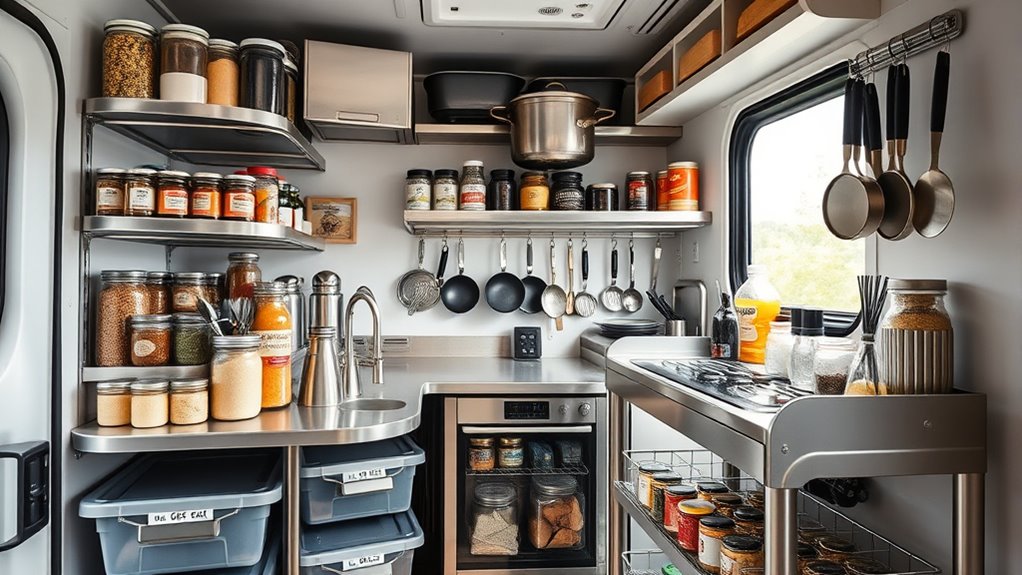
Efficient inventory management relies not only on digital tools but also on how well you organize your storage space. A tidy, well-structured setup improves kitchen aesthetics, making it easier to locate supplies quickly. Use clear labels and designated zones for different item categories, ensuring everything has a specific place. Regular staff training is essential so everyone understands the organization system and maintains consistency. Keep frequently used items within arm’s reach and store less-used supplies in higher or lower areas. Utilize stackable containers and shelving to maximize space. Maintaining a visually appealing, organized environment boosts productivity and reduces clutter. When your storage space is streamlined, managing inventory becomes smoother, ultimately supporting a more organized mobile kitchen operation.
Monitoring and Analyzing Inventory Data for Improvement

Monitoring and analyzing your inventory data is essential for identifying trends, preventing shortages, and reducing waste. With effective data visualization, you can quickly spot patterns and anomalies. To improve your inventory management, focus on these key steps:
- Track inventory levels regularly to identify seasonal fluctuations.
- Use sales forecasting to predict future demand accurately.
- Implement visual dashboards that display real-time stock data for quick decisions.
- Analyze historical data to refine stocking strategies and minimize excess.
- Understanding inventory management principles helps optimize supply levels and avoid overstocking or stockouts.
Frequently Asked Questions
How Do I Handle Inventory Theft or Loss?
You should implement theft prevention strategies and establish clear loss tracking procedures. Keep your inventory organized and secure, only allowing trusted staff access. Regularly monitor and record supplies to spot discrepancies early. Use inventory software or logs to track losses and identify patterns. Communicate clearly about theft policies and consequences. By staying vigilant and maintaining accurate records, you minimize theft risks and quickly address any supply loss issues.
What Are Best Practices for Inventory Safety and Sanitation?
You should prioritize inventory safety and sanitation standards by implementing strict inventory tracking methods, like regular audits and digital records. Keep supplies organized and secure to prevent theft or loss. Follow sanitation protocols diligently, ensuring all surfaces and utensils are cleaned and sanitized frequently. Train staff on safety procedures, and use proper storage practices to maintain both safety and cleanliness, helping your mobile kitchen stay compliant and hygienic.
How Can I Reduce Inventory Costs Effectively?
To reduce inventory costs effectively, you should focus on accurate inventory tracking to avoid overstocking or shortages. Strengthen supplier relationships to negotiate better prices and delivery terms. Regularly review your inventory levels and sales data to forecast demand more accurately. Implement just-in-time ordering to minimize excess stock. By staying organized and maintaining good supplier communication, you can cut costs while ensuring your mobile kitchen runs smoothly.
What Legal Considerations Exist for Inventory Management?
Think of legal considerations as the map guiding your inventory journey. You need to guarantee your inventory tracking complies with local laws and regulations to avoid pitfalls. Staying on the right side of legal compliance means regularly updating records, following health and safety standards, and understanding licensing requirements. By doing so, your mobile kitchen stays on course, avoiding penalties and ensuring smooth operation through transparent and lawful inventory management.
How Do I Train Staff on Inventory Procedures?
You should start by clearly explaining your inventory tracking procedures to your staff, emphasizing accurate recording and regular checks. Use hands-on staff training to demonstrate how to log supplies properly, and provide written guidelines for reference. Encourage questions to guarantee understanding. Regularly review procedures, offer feedback, and reinforce the importance of inventory management, so your team stays consistent and confident in following proper inventory tracking methods.
Conclusion
By staying organized and proactive, managing your mobile kitchen’s inventory becomes second nature—like a well-oiled machine. Regularly track supplies, build strong supplier relationships, and use technology to stay ahead. Handle shortages swiftly and keep your storage space tidy. With these strategies, you’ll keep your kitchen running smoothly, ensuring you’re always prepared, like a chef with all ingredients at hand. Mastering inventory management turns chaos into clarity, so your mobile kitchen thrives on every busy day.
